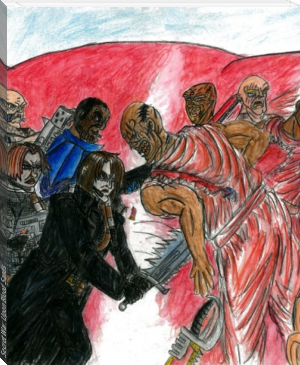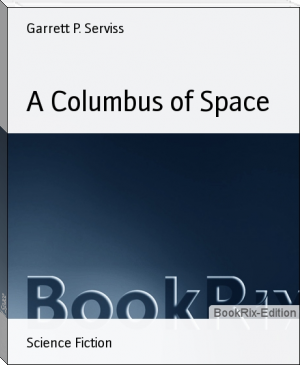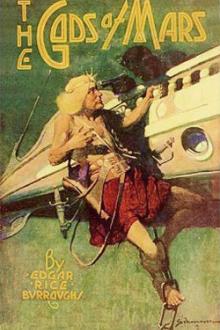Edison's Conquest of Mars by Garrett Putman Serviss (ebook reader 8 inch txt) 📖

Download in Format:
- Author: Garrett Putman Serviss
Book online «Edison's Conquest of Mars by Garrett Putman Serviss (ebook reader 8 inch txt) 📖». Author Garrett Putman Serviss
of asphyxiation. They, as well as those who lay upon the exterior, were immediately removed to the flagship, restoratives were applied, and, fortunately, our aid had come so promptly that the lives of all of them were saved. But life had fled from the mangled bodies of those who had stood directly in the path of the fearful projectile.
This strange accident had been witnessed by several of the members of the fleet, and they quickly drew together, in order to inquire for the particulars. As the flagship was now overcrowded by the addition of so many men to its crew, Mr. Edison had them distributed among the other cars. Fortunately it happened that the disintegrators contained in the wrecked car were not injured. Mr. Edison thought that it would be possible to repair the car itself, and for that purpose he had it attached to the flagship in order that it might be carried on as far as the moon. The bodies of the dead were transported with it, as it was determined, instead of committing them to the fearful deep of space, where they would have wandered forever, or else have fallen like meteors upon the earth, to give them interment in the lunar soil.
Nearing the Moon.
As we now rapidly approached the moon the change which the appearance of its surface underwent was no less wonderful than that which the surface of the earth had presented in the reverse order while we were receding from it. From a pale silver orb, shining with comparative faintness among the stars, it slowly assumed the appearance of a vast mountainous desert. As we drew nearer its colors became more pronounced; the great flat regions appeared darker; the mountain peaks shone more brilliantly. The huge chasms seemed bottomless and blacker than midnight. Gradually separate mountains appeared. What seemed like expanses of snow and immense glaciers streaming down their sides sparkled with great brilliancy in the perpendicular rays of the sun. Our motion had now assumed the aspect of falling. We seemed to be dropping from an immeasurable height and with an inconceivable velocity, straight down upon those giant peaks.
The Mountains of Luna.
Here and there curious lights glowed upon the mysterious surface of the moon. Where the edge of the moon cut the sky behind it, it was broken and jagged with mountain masses. Vast crater rings overspread its surface, and in some of these I imagined I could perceive a lurid illumination coming out of their deepest cavities, and the curling of mephitic vapors around their terrible jaws.
We were approaching that part of the moon which is known to astronomers as the Bay of Rainbows. Here a huge semi-circular region, as smooth almost as the surface of a prairie, lay beneath our eyes, stretching southward into a vast ocean-like expanse, while on the north it was enclosed by an enormous range of mountain cliffs, rising perpendicularly to a height of many thousands of feet, and rent and gashed in every direction by forces which seemed at some remote period to have labored at tearing this little world in pieces.
A Dead And Mangled World.
The Moon's Strange and Ghastly Surface in Full View of Man.
It was a fearful spectacle; a dead and mangled world, too dreadful to look upon. The idea of the death of the moon was, of course, not a new one to many of us. We had long been aware that the earth's satellite was a body which had passed beyond the stage of life, if indeed it had ever been a life supporting globe; but none of us were prepared for the terrible spectacle which now smote our eyes.
At each end of the semi-circular ridge that encloses the Bay of Rainbows there is a lofty promontory. That at the north-western extremity had long been known to astronomers under the name of Cape Laplace. The other promontory, at the southeastern termination, is called Cape Heraclides. It was toward the latter that we were approaching, and by interchange of signals all the members of the squadron had been informed that Cape Heraclides was to be our rendezvous upon the moon.
I may say that I had been somewhat familiar with the scenery of this part of the lunar world, for I had often studied it from the earth with a telescope, and I had thought that if there was any part of the moon where one might, with fair expectation of success, look for inhabitants, or if not for inhabitants, at least for relics of life no longer existent there, this would surely be the place. It was, therefore, with no small degree of curiosity, notwithstanding the unexpectedly frightful and repulsive appearance that the surface of the moon presented, that I now saw myself rapidly approaching the region concerning whose secrets my imagination had so often busied itself. When Mr. Edison and I had paid our previous visit to the moon on the first experimental trip of the electrical ship, we had landed at a point on its surface remote from this, and, as I have before explained, we then made no effort to investigate its secrets. But now it was to be different, and we were at length to see something of the wonders of the moon.
Like a Human Face.
I had often on the earth drawn a smile from my friends by showing them Cape Heraclides with a telescope, and calling their attention to the fact that the outline of the peak terminating the cape was such as to present a remarkable resemblance to a human face, unmistakably a feminine countenance, seen in profile, and possessing no small degree of beauty. To my astonishment, this curious human semblance still remained when we had approached so close to the moon that the mountains forming the cape filled nearly the whole field of view of the window from which I was watching it. The resemblance, indeed, was most startling.
The Resemblance Disappears.
"Can this indeed be Diana herself?" I said half aloud, but instantly afterward I was laughing at my fancy, for Mr. Edison had overheard me and exclaimed, "Where is she?"
"Who?"
"Diana."
"Why, there," I said, pointing to the moon. But lo! the appearance was gone even while I spoke. A swift change had taken place in the line of sight by which we were viewing it, and the likeness had disappeared in consequence.
A few moments later my astonishment was revived, but the cause this time was a very different one. We had been dropping rapidly toward the mountains, and the electrician in charge of the car was swiftly and constantly changing his potential, and, like a pilot who feels his way into an unknown harbor, endeavoring to approach the moon in such a manner that no hidden peril should surprise us. As we thus approached I suddenly perceived, crowning the very apex of the lofty peak near the termination of the cape, the ruins of what appeared to be an ancient watch tower. It was evidently composed of Cyclopean blocks larger than any that I had ever seen even among the ruins of Greece, Egypt and Asia Minor.
The Moon Was Inhabited.
Here, then, was visible proof that the moon had been inhabited, although probably it was not inhabited now. I cannot describe the exultant feeling which took possession of me at this discovery. It settled so much that learned men had been disputing about for centuries.
"What will they say," I exclaimed, "when I show them a photograph of that?"
Below the peak, stretching far to right and left, lay a barren beach which had evidently once been washed by sea waves, because it was marked by long curved ridges such as the advancing and retiring tide leaves upon the shore of the ocean.
This beach sloped rapidly outward and downward toward a profound abyss, which had once, evidently, been the bed of a sea, but which now appeared to us simply as the empty, yawning shell of an ocean that had long vanished.
It was with no small difficulty, and only after the expenditure of considerable time, that all the floating ships of the squadron were gradually brought to rest on this lone mountain top of the moon. In accordance with my request, Mr. Edison had the flagship moored in the interior of the great ruined watch tower that I have described. The other ships rested upon the slope of the mountain around us.
Although time pressed, for we knew that the safety of the earth depended upon our promptness in attacking Mars, yet it was determined to remain here at least two or three days in order that the wrecked car might be repaired. It was found also that the passage of the highly electrified meteor had disarranged the electrical machinery in some of the other cars, so that there were many repairs to be made besides those needed to restore the wreck.
Burying the Dead.
Moreover, we must bury our unfortunate companions who had been killed by the meteor. This, in fact, was the first work that we performed. Strange was the sight, and stranger our feelings, as here on the surface of a world distant from the earth, and on soil which had never before been pressed by the foot of man, we performed that last ceremony of respect which mortals pay to mortality. In the ancient beach at the foot of the peak we made a deep opening, and there covered forever the faces of our friends, leaving them to sleep among the ruins of empires, and among the graves of races which had vanished probably ages before Adam and Eve appeared in Paradise.
While the repairs were being made several scientific expeditions were sent out in various directions across the moon. One went westward to investigate the great ring plain of Plato, and the lunar Alps. Another crossed the ancient Sea of Showers toward the lunar Apennines.
One started to explore the immense crater of Copernicus, which, yawning fifty miles across, presents a wonderful appearance even from the distance of the earth. The ship in which I, myself, had the good fortune to embark, was bound for the mysterious lunar mountain Aristarchus.
Before these expeditions started, a careful exploration had been made in the neighborhood of Cape Heraclides. But, except that the broken walls of the watch tower on the peak, composed of blocks of enormous size, had evidently been the work of creatures endowed with human intelligence, no remains were found indicating the former presence of inhabitants upon this part of the moon.
A Gigantic Human Footprint.
But along the shore of the old sea, just where the so-called Bay of Rainbows separates itself from the abyss of the Sea of Showers, there were found some stratified rocks in which the fascinated eyes of the explorer beheld the clear imprint of a gigantic human foot, measuring five feet in length from toe to heel.
Detailing the Marvellous Adventures of the Earth's Warriors in Unknown Worlds.
The most minute search failed to reveal another trace of the presence of the ancient giant, who had left the impress of his foot in the wet sands of the beach here so many millions of years ago that even the imagination of the geologists shrank from the task of attempting to fix the precise period.
The Great Footprint.
Around this gigantic footprint gathered most of the scientific members of the expedition, wearing their oddly shaped air-tight suits, connected with telephonic wires, and the spectacle, but for the impressiveness of the discovery, would have been laughable in the extreme. Bending over the mark in the rock, nodding their heads
This strange accident had been witnessed by several of the members of the fleet, and they quickly drew together, in order to inquire for the particulars. As the flagship was now overcrowded by the addition of so many men to its crew, Mr. Edison had them distributed among the other cars. Fortunately it happened that the disintegrators contained in the wrecked car were not injured. Mr. Edison thought that it would be possible to repair the car itself, and for that purpose he had it attached to the flagship in order that it might be carried on as far as the moon. The bodies of the dead were transported with it, as it was determined, instead of committing them to the fearful deep of space, where they would have wandered forever, or else have fallen like meteors upon the earth, to give them interment in the lunar soil.
Nearing the Moon.
As we now rapidly approached the moon the change which the appearance of its surface underwent was no less wonderful than that which the surface of the earth had presented in the reverse order while we were receding from it. From a pale silver orb, shining with comparative faintness among the stars, it slowly assumed the appearance of a vast mountainous desert. As we drew nearer its colors became more pronounced; the great flat regions appeared darker; the mountain peaks shone more brilliantly. The huge chasms seemed bottomless and blacker than midnight. Gradually separate mountains appeared. What seemed like expanses of snow and immense glaciers streaming down their sides sparkled with great brilliancy in the perpendicular rays of the sun. Our motion had now assumed the aspect of falling. We seemed to be dropping from an immeasurable height and with an inconceivable velocity, straight down upon those giant peaks.
The Mountains of Luna.
Here and there curious lights glowed upon the mysterious surface of the moon. Where the edge of the moon cut the sky behind it, it was broken and jagged with mountain masses. Vast crater rings overspread its surface, and in some of these I imagined I could perceive a lurid illumination coming out of their deepest cavities, and the curling of mephitic vapors around their terrible jaws.
We were approaching that part of the moon which is known to astronomers as the Bay of Rainbows. Here a huge semi-circular region, as smooth almost as the surface of a prairie, lay beneath our eyes, stretching southward into a vast ocean-like expanse, while on the north it was enclosed by an enormous range of mountain cliffs, rising perpendicularly to a height of many thousands of feet, and rent and gashed in every direction by forces which seemed at some remote period to have labored at tearing this little world in pieces.
A Dead And Mangled World.
The Moon's Strange and Ghastly Surface in Full View of Man.
It was a fearful spectacle; a dead and mangled world, too dreadful to look upon. The idea of the death of the moon was, of course, not a new one to many of us. We had long been aware that the earth's satellite was a body which had passed beyond the stage of life, if indeed it had ever been a life supporting globe; but none of us were prepared for the terrible spectacle which now smote our eyes.
At each end of the semi-circular ridge that encloses the Bay of Rainbows there is a lofty promontory. That at the north-western extremity had long been known to astronomers under the name of Cape Laplace. The other promontory, at the southeastern termination, is called Cape Heraclides. It was toward the latter that we were approaching, and by interchange of signals all the members of the squadron had been informed that Cape Heraclides was to be our rendezvous upon the moon.
I may say that I had been somewhat familiar with the scenery of this part of the lunar world, for I had often studied it from the earth with a telescope, and I had thought that if there was any part of the moon where one might, with fair expectation of success, look for inhabitants, or if not for inhabitants, at least for relics of life no longer existent there, this would surely be the place. It was, therefore, with no small degree of curiosity, notwithstanding the unexpectedly frightful and repulsive appearance that the surface of the moon presented, that I now saw myself rapidly approaching the region concerning whose secrets my imagination had so often busied itself. When Mr. Edison and I had paid our previous visit to the moon on the first experimental trip of the electrical ship, we had landed at a point on its surface remote from this, and, as I have before explained, we then made no effort to investigate its secrets. But now it was to be different, and we were at length to see something of the wonders of the moon.
Like a Human Face.
I had often on the earth drawn a smile from my friends by showing them Cape Heraclides with a telescope, and calling their attention to the fact that the outline of the peak terminating the cape was such as to present a remarkable resemblance to a human face, unmistakably a feminine countenance, seen in profile, and possessing no small degree of beauty. To my astonishment, this curious human semblance still remained when we had approached so close to the moon that the mountains forming the cape filled nearly the whole field of view of the window from which I was watching it. The resemblance, indeed, was most startling.
The Resemblance Disappears.
"Can this indeed be Diana herself?" I said half aloud, but instantly afterward I was laughing at my fancy, for Mr. Edison had overheard me and exclaimed, "Where is she?"
"Who?"
"Diana."
"Why, there," I said, pointing to the moon. But lo! the appearance was gone even while I spoke. A swift change had taken place in the line of sight by which we were viewing it, and the likeness had disappeared in consequence.
A few moments later my astonishment was revived, but the cause this time was a very different one. We had been dropping rapidly toward the mountains, and the electrician in charge of the car was swiftly and constantly changing his potential, and, like a pilot who feels his way into an unknown harbor, endeavoring to approach the moon in such a manner that no hidden peril should surprise us. As we thus approached I suddenly perceived, crowning the very apex of the lofty peak near the termination of the cape, the ruins of what appeared to be an ancient watch tower. It was evidently composed of Cyclopean blocks larger than any that I had ever seen even among the ruins of Greece, Egypt and Asia Minor.
The Moon Was Inhabited.
Here, then, was visible proof that the moon had been inhabited, although probably it was not inhabited now. I cannot describe the exultant feeling which took possession of me at this discovery. It settled so much that learned men had been disputing about for centuries.
"What will they say," I exclaimed, "when I show them a photograph of that?"
Below the peak, stretching far to right and left, lay a barren beach which had evidently once been washed by sea waves, because it was marked by long curved ridges such as the advancing and retiring tide leaves upon the shore of the ocean.
This beach sloped rapidly outward and downward toward a profound abyss, which had once, evidently, been the bed of a sea, but which now appeared to us simply as the empty, yawning shell of an ocean that had long vanished.
It was with no small difficulty, and only after the expenditure of considerable time, that all the floating ships of the squadron were gradually brought to rest on this lone mountain top of the moon. In accordance with my request, Mr. Edison had the flagship moored in the interior of the great ruined watch tower that I have described. The other ships rested upon the slope of the mountain around us.
Although time pressed, for we knew that the safety of the earth depended upon our promptness in attacking Mars, yet it was determined to remain here at least two or three days in order that the wrecked car might be repaired. It was found also that the passage of the highly electrified meteor had disarranged the electrical machinery in some of the other cars, so that there were many repairs to be made besides those needed to restore the wreck.
Burying the Dead.
Moreover, we must bury our unfortunate companions who had been killed by the meteor. This, in fact, was the first work that we performed. Strange was the sight, and stranger our feelings, as here on the surface of a world distant from the earth, and on soil which had never before been pressed by the foot of man, we performed that last ceremony of respect which mortals pay to mortality. In the ancient beach at the foot of the peak we made a deep opening, and there covered forever the faces of our friends, leaving them to sleep among the ruins of empires, and among the graves of races which had vanished probably ages before Adam and Eve appeared in Paradise.
While the repairs were being made several scientific expeditions were sent out in various directions across the moon. One went westward to investigate the great ring plain of Plato, and the lunar Alps. Another crossed the ancient Sea of Showers toward the lunar Apennines.
One started to explore the immense crater of Copernicus, which, yawning fifty miles across, presents a wonderful appearance even from the distance of the earth. The ship in which I, myself, had the good fortune to embark, was bound for the mysterious lunar mountain Aristarchus.
Before these expeditions started, a careful exploration had been made in the neighborhood of Cape Heraclides. But, except that the broken walls of the watch tower on the peak, composed of blocks of enormous size, had evidently been the work of creatures endowed with human intelligence, no remains were found indicating the former presence of inhabitants upon this part of the moon.
A Gigantic Human Footprint.
But along the shore of the old sea, just where the so-called Bay of Rainbows separates itself from the abyss of the Sea of Showers, there were found some stratified rocks in which the fascinated eyes of the explorer beheld the clear imprint of a gigantic human foot, measuring five feet in length from toe to heel.
Detailing the Marvellous Adventures of the Earth's Warriors in Unknown Worlds.
The most minute search failed to reveal another trace of the presence of the ancient giant, who had left the impress of his foot in the wet sands of the beach here so many millions of years ago that even the imagination of the geologists shrank from the task of attempting to fix the precise period.
The Great Footprint.
Around this gigantic footprint gathered most of the scientific members of the expedition, wearing their oddly shaped air-tight suits, connected with telephonic wires, and the spectacle, but for the impressiveness of the discovery, would have been laughable in the extreme. Bending over the mark in the rock, nodding their heads
Free ebook «Edison's Conquest of Mars by Garrett Putman Serviss (ebook reader 8 inch txt) 📖» - read online now
Similar e-books:





Comments (0)